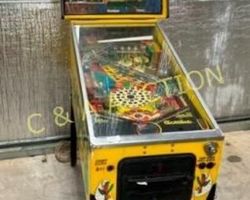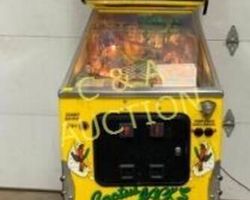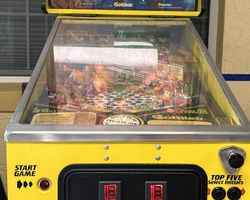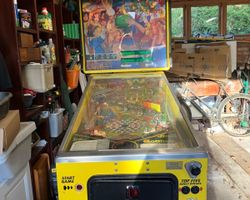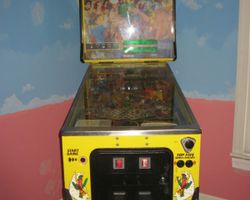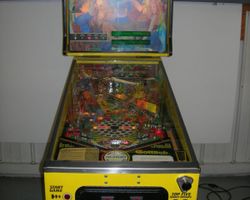Cactus Jack's
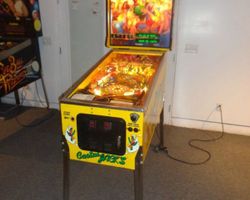
Average Prices: USD $600 to $1,700
Produced: April, 1991
Production Run: 1,900 units
Machine Type: Solid State Electronic
MPU: Gottlieb System 3
Players: 4
Design by: Jon Norris, Reinhard Bangerter
Art by: Constantino Mitchell, David Moore, Jeanine Mitchell
Sound by: Dave Zabriskie
Software by: Allen Edwall
Released in April 1991 by Premier Technology, also known as D. Gottlieb & Co., the pinball machine "Cactus Jack's" arrived with a distinctive personality, a departure from the more serious or licensed themes prevalent in the era. Bearing the Model Number 729, this Solid State Electronic (SS) game was a product of the Gottlieb System 3 generation, a platform known for its robust and dependable nature. With a production run of 1,900 units, "Cactus Jack's" carved out its niche, inviting players to a rollicking, boot-stomping good time as heralded by its marketing slogans: "Yee-Hah! Let's Party!!!", "Let's Have a Boot-Stompin Good Time!", and "You Ready for a Good Old Time?--Welcome to Cactus JACK'S".
History and Background
The conceptualization of "Cactus Jack's" sprang from the creative minds of designers Jon Norris and Reinhard Bangerter. This duo also collaborated on "Class of 1812," which was released the same year, subtly influencing the design philosophy and playfield flow of "Cactus Jack's." The theme itself is an eccentric blend of Western comedy, music, and an underlying "food fight" motif. It features singing and dancing country-western elements, all brought to life through the vibrant and whimsical artwork of Constantino Mitchell, David Moore, and Jeanine Mitchell. Their contribution is evident in the machine's colorful cabinet, often a bright yellow, and its cartoonish yet expressive playfield elements.
The auditory experience of "Cactus Jack's" was crafted by Dave Zabriskie, responsible for both the music and sound effects. This machine introduced a new sound board design for Gottlieb, allowing for custom speech and a dynamic soundscape that perfectly complements its offbeat theme. The software, which orchestrated the game's logic and interactivity, was developed by Allen Edwall. The collaborative efforts of these individuals resulted in a pinball machine that, while not produced in the highest numbers, offered a unique and memorable experience within the System 3 lineage.
Signature Features and Design
"Cactus Jack's" distinguishes itself with several standout elements that elevate its quirky theme into tangible gameplay features. The most prominent of these are the mechanical cacti positioned at the back of the playfield. These animatronic characters "dance" and sway during critical game moments, such as multiball and special events, adding a visual spectacle and contributing significantly to the machine's comedic charm. This animated element, while visually engaging, also influences the playfield's overall length, making it slightly shorter than some contemporary designs.
The machine's artwork is central to its identity. The playfield is adorned with vibrant colors and caricatured depictions of characters engaged in a Western-themed party, complete with fruit-throwing antics. This aesthetic is consistently applied across the playfield, cabinet, and backglass, creating a cohesive visual narrative that reinforces the game's lighthearted and often absurd atmosphere. Complementing the artwork is a dynamic light show across the playfield, enhancing the visual feedback during gameplay and highlighting specific shots and modes. The sound design, utilizing the new sound board, features custom speech callouts that are amusing and thematic, alongside energetic polka and banjo music that often becomes a memorable earworm for players. An alphanumeric display provides clear scoring and game information, maintaining the era's standard while effectively communicating game progress.
Playfield and Mechanics
The playfield of "Cactus Jack's" is structured to deliver a fast-paced and ramp-intensive experience, encouraging quick reflexes and shot accuracy. It features two flippers at the player's disposal and a manual plunger to initiate gameplay. The layout incorporates two prominent ramps, a primary scoring avenue for many players. Three pop bumpers located strategically within the playfield create chaotic ball action, while a total of eight drop targets, arranged in two 4-bank sets, offer scoring opportunities and mode progression. Three standup targets are also integrated into the layout, and a vertical up-kicker adds another dimension to ball movement.
The design philosophy behind "Cactus Jack's" centers on accessibility and flow. Shots are generally open, allowing for a satisfying rhythm as the ball travels across the playfield. The left ramp, in particular, is noted for its consistent shot opportunity, often becoming a primary target for high scores. While the drop targets contribute to the overall objectives, their frequency of engagement can vary, which some players note. The interactive dancing cacti at the upper playfield are not just visual flair but also integrate into the game's objectives. The artwork on the playfield is meticulously integrated with the mechanical elements, with colorful inserts and graphics guiding players toward shots and highlighting active features, all under the vibrant lighting that accentuates the game's visual appeal.
Gameplay Dynamics
"Cactus Jack's" offers a gameplay experience that is straightforward yet engaging, making it highly approachable for both casual players and pinball enthusiasts. The core gameplay mechanics revolve around achieving multiball and activating the "throwing fruit" objective. Players aim to hit various targets and ramps to light up progress towards these modes. Once multiball is achieved, the mechanical cacti come to life, dancing along with the game's energetic music, and players can then focus on hitting specific targets to "throw fruit," which contributes significantly to their score.
The rule set is designed to be easily understood, allowing players to quickly grasp the objectives without needing to delve into complex strategic layers. This simplicity contributes to its reputation as an excellent "party pinball machine," where quick games and immediate enjoyment take precedence over deep, multi-layered rule sets. While the left ramp shot is a reliable method for accumulating points, leading some to describe it as a "one-shot wonder," the game still encourages diverse shot-making to maximize scoring potential and explore all its features. The challenges in "Cactus Jack's" often stem from its quick drains, particularly a wider center drain, which can make for a more demanding game for some players, though others appreciate the increased challenge.
Reception and Legacy
"Cactus Jack's" has cultivated a surprisingly positive reputation within the pinball community, often celebrated as an "underrated" and genuinely "fun" machine. Its strengths lie in its immediate accessibility, making it an ideal choice for new players or for social gatherings. The whimsical, unpretentious theme of dancing cacti and fruit-throwing, coupled with its catchy polka and banjo music, is frequently cited as a refreshing change from more serious or licensed titles, contributing to its unique charm. The energetic sound package, including custom callouts, and the dynamic light show further enhance the player's experience. Many players appreciate the simple rule set, which allows for quick, enjoyable games without demanding extensive study of complex strategies. Its flow and shot satisfaction are also consistently praised. Furthermore, as a Gottlieb System 3 game, it benefits from the platform's reputation for durability and dependability.
However, "Cactus Jack's" is not without its points of contention. For players who prioritize deep rule sets and long-term strategic engagement, the game's relative simplicity can lead to a sense of repetitiveness. The emphasis on the left ramp for scoring, while offering a clear objective, sometimes results in a "one-shot wonder" playstyle that can diminish replayability for some. While the audio is generally well-received, a minority of players find the music and callouts to become repetitive over extended play. The vibrant artwork, while distinctive, can be divisive; some praise its colorful eccentricity, while others find certain elements, such as the backglass, less appealing. Minor criticisms have also been directed at some playfield design aspects, such as drop targets not being engaged as frequently as some might wish, or the visibility of certain ramp openings being obscured by habitrails. The shorter playfield, a consequence of the mechanical cacti in the back, is another noted design characteristic. Despite these criticisms, its enduring appeal as a lighthearted and enjoyable experience has cemented its place as a distinctive entry in the Gottlieb System 3 era.
Sponsored Links
 Ebay Listings
Ebay Listings
 Auction Results
Auction Results
| Cost | Location | Date |
|---|---|---|
| USD $2,500 |  Virginia, United States Virginia, United States |
12 October, 2024 |
| USD $850 |  North Carolina, United States North Carolina, United States |
14 July, 2024 |
| GBP £1,131 |  Warwick, United Kingdom Warwick, United Kingdom |
17 December, 2023 |
| USD $2,750 |  Florida, United States Florida, United States |
05 June, 2023 |
| USD $1,400 |  Virginia, United States Virginia, United States |
03 June, 2023 |
| USD $2,400 |  Nebraska, United States Nebraska, United States |
12 July, 2021 |
| AUD $1,764 |  New South Wales, Australia New South Wales, Australia |
01 July, 2020 |
| USD $1,900 |  Colorado, United States Colorado, United States |
21 July, 2019 |
| AUD $3,400 |  Queensland, Australia Queensland, Australia |
09 September, 2018 |
| AUD $2,995 |  Victoria, Australia Victoria, Australia |
22 August, 2018 |


Private Policy · Search Website · Contact Us
As an eBay Partner, we may earn a commission from qualifying purchases made through links on this site, at no additional cost to you.
All trademarks and copyrighted materials remain property of their respective owners. All other content copyright 2007 - 2026 Pinpedia.

